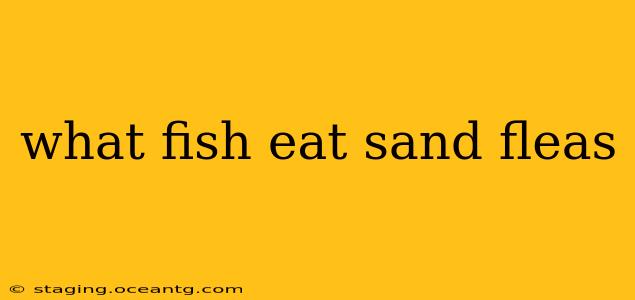Sand fleas, also known as amphipods or beach hoppers, are a crucial part of the coastal ecosystem. Many fish species rely on them as a significant food source. Understanding which fish prey on sand fleas can provide valuable insight into the delicate balance of the marine food web. This guide explores various fish species that include sand fleas in their diet, examining their feeding habits and habitats.
What Types of Fish Eat Sand Fleas?
Numerous fish species consume sand fleas, ranging from small baitfish to larger predatory species. The specific fish present will vary greatly depending on the geographic location and the specific type of sand flea available. However, some common culprits include:
-
Smaller Fish: Many smaller fish species, especially those inhabiting shallow coastal waters, actively forage for sand fleas. These often include juvenile fish of larger predatory species, as well as species that specialize in bottom-feeding. Examples could include certain species of gobies, blennies, and small wrasses. These fish often use their mouths to pick sand fleas off the sand or rocks.
-
Larger Predatory Fish: While sand fleas may not be the primary food source for many larger predators, they still play a role in their diet. Larger fish might consume sand fleas opportunistically while hunting other prey. This might include species like flounder, which often lie buried in the sand, making them well-placed to ambush sand fleas. Some larger drum species also incorporate sand fleas into their diet.
-
Shorebirds and Other Coastal Creatures: It's important to note that fish are not the only creatures that consume sand fleas. Many shorebirds, crabs, and other invertebrates also prey upon them. Understanding the entire food web is critical to understanding the role sand fleas play within their environment.
Where Do These Fish Live?
The location where you'll find fish that eat sand fleas is directly correlated with where the sand fleas themselves thrive. These tiny crustaceans prefer areas with sandy or gravelly bottoms, often in the intertidal zone (the area between high and low tide). Consequently, the fish that feed on them are most commonly found in:
-
Shallow Coastal Waters: These are prime habitats for sand fleas and the fish that prey upon them. Look in shallow bays, estuaries, and along the shoreline.
-
Surf Zones: The area where waves break can also support high populations of sand fleas and the fish that feed on them.
-
Rocky Shores: Areas with a mixture of sand and rocks often provide excellent habitat for sand fleas and the fish that feed on them.
What Other Organisms Feed on Sand Fleas?
H3: What birds eat sand fleas?
Many shorebirds, such as sanderlings and dunlin, regularly forage for sand fleas along the shoreline. Their long, slender beaks are well-suited for probing the sand and picking out these tiny crustaceans.
H3: Do crabs eat sand fleas?
Yes, several crab species, especially smaller burrowing crabs, readily consume sand fleas. They often find them while scavenging in the sand.
Conclusion: The Importance of Sand Fleas in the Food Web
Sand fleas are a vital link in the coastal food chain. Their abundance provides a crucial food source for a wide variety of fish, birds, and other animals. Understanding the predators of sand fleas helps us appreciate the complex interdependencies within marine ecosystems and the importance of maintaining healthy coastal environments. Further research on specific fish species and their diets in various geographic locations would provide a more nuanced understanding of this ecological relationship.
